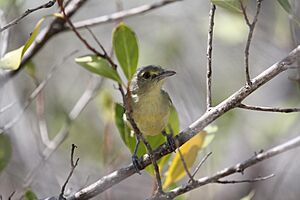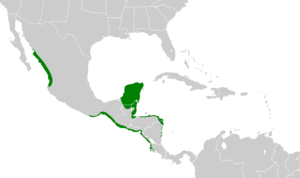Mangrove vireo facts for kids
Quick facts for kids Mangrove vireo |
|
|---|---|
 |
|
| Conservation status | |
| Scientific classification | |
| Genus: |
Vireo
|
| Species: |
pallens
|
 |
|
The mangrove vireo (Vireo pallens) is a small bird that belongs to the Vireonidae family. These birds are known for living in warm, tropical areas.
What Does the Mangrove Vireo Look Like?
The mangrove vireo is a plain-looking bird. It is usually olive or olive-grey in color. It has bright yellow areas around its eyes, called lores. You can also spot two white stripes on its wings. Both male and female mangrove vireos look very similar. They are quite small, only about 10 centimeters (4 inches) long.
There are two main groups of these birds. One group lives near the Caribbean Sea. The other group lives near the Pacific Ocean. The Caribbean birds can be either yellow or grey. But the Pacific birds are always the same color.
Where Do Mangrove Vireos Live?
You can find mangrove vireos in several countries. These include Belize, Costa Rica, El Salvador, Guatemala, Honduras, Mexico, and Nicaragua.
They live in different kinds of places. Some prefer warm, dry forests. Others live in tropical mangrove forests, which are found along coastlines. They can also be found in dry shrubland, which is land covered in small bushes.
The birds living near the Pacific Ocean mostly stay in mangrove forests. But the Caribbean birds live in more types of places. They can be found in a wider range of habitats.
Is the Mangrove Vireo in Danger?
The IUCN (International Union for Conservation of Nature) checks on animals. They have looked at the mangrove vireo. They say it is a species of "Least Concern." This means that the mangrove vireo is not currently in danger of disappearing. Its population is stable and healthy.


